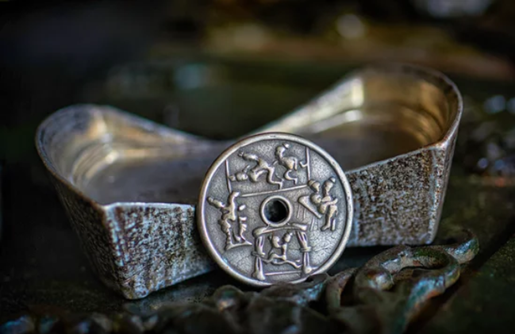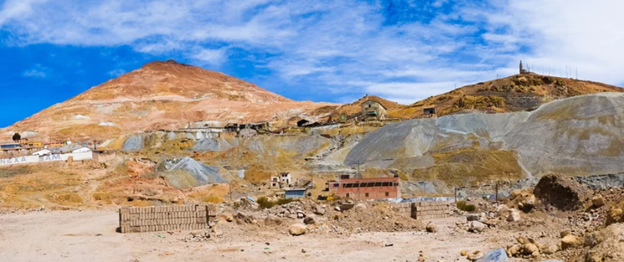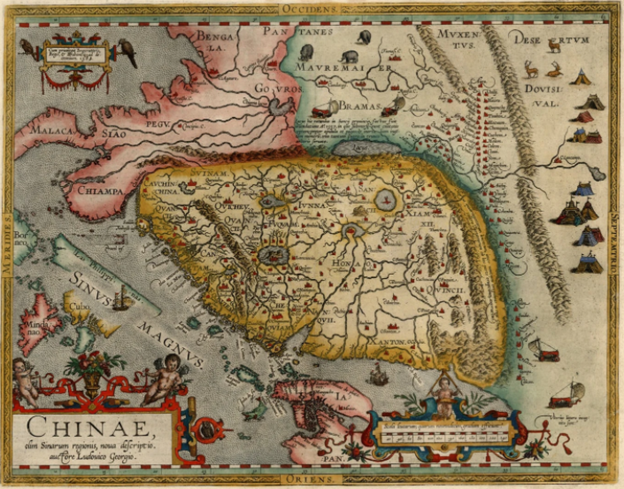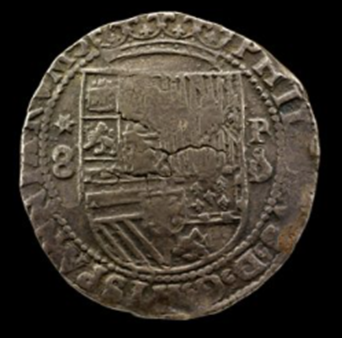There was a time when China had an appetite for silver, and the West hungered for Chinese goods.
In a world dominated by paper currencies, we sometimes forget the role of gold and silver in fostering international trade and creating the basis of the monetary system as we know it today.
Many scholars consider the silver trade to mark the beginning of the global economy, with one historian noting that silver “went round the world and made the world go round.”
The precious metal has made an indelible mark on Chinese history, helping both to build an empire and to destroy it.

In this article we explain how the world was transformed when the king of Spain’s silver met the tax demands of the emperor of China, when for the first time the whole world was linked into one global network whose most important element was silver, and how China came to dominate at the dawn of world trade over 400 years ago.
The Spanish in the New World
Our story begins in modern-day Bolivia, what was then Peru, a fledgling outpost of the Spanish colonial empire, at the edge of the New World.
That all changed in the mid-1500s with the discovery of silver high in the Bolivian Andes, near a village called Potosi.
According to local mythology, a shepherd was grazing his herd of llamas when one of them got lost. The man became stranded and ended up spending the night, lighting a bonfire to keep warm. When he awoke the next morning, the fire had produced a curtain of melted silver threads that flowed down the hillside.
The Spanish called the discovery Cerro Rico, which means “rich mountain”; indeed, this silver was the purest the world had ever seen. It unleashed a silver rush that saw the tiny village of Potosi expand to 160,000 in just 60 years — surely one of the greatest boom town stories in the history of mining.
But the Spanish had a dilemma: how to find enough manpower to work the rich underground veins.
At first, they enslaved the local indigenous people, and then, after the indigenous were decimated through warfare or foreign diseases, they turned to slaves from Africa.
Over the centuries millions of African slaves and indigenous died breaking rocks for New World silver, including from Cerro Rico, which the Indians called “the mountain that eats men”.

It is thought that half the world’s silver in the 16th century came from upper Peru. In 1581 the Spanish found a ready buyer in another part of the world they had discovered — the Philippines, named after King Philip II of Spain, who ruled from 1527-98.
Philippines stop-over
At the time, Filipinos were engaged in low-level trade with Chinese merchants, who would sail their junks from ports like Canton (now Guangzhou) and Hong Kong, to Manila, bringing items like silk and porcelain for sale.
After the first ships began arriving from Peru, thousands more Chinese traders flocked to Manila with luxury goods they would sell to the Spanish, before sailing home with their junks laden with New World silver.
Why were the Chinese so interested in the precious metal? The easy answer is that China didn’t want any of the goods the Spanish could offer them. To level the balance of trade, they traded Chinese goods for silver.
Taxes paid in silver
The more complex reason has to do with China’s unwieldy tax regime.
For much of its history China was ruled by a series of royal dynasties. The emperor of the Ming dynasty presided over a quarter of the world’s population, and early maps depicted China as the center of the known world. This is why Chinese, then and now, refer to their country as Zhonggou, the “Middle Kingdom”.

Since the travels of Marco Polo in the 13th century, Europeans were dazzled by China’s scale and sophistication; its buildings, arts and culture seemed more advanced than Western Europe, and the Chinese Emperor appeared to be wealthier than even the richest European kings.
However, the Ming rulers had a problem that impeded China’s growth. The system of collecting taxes was complicated because there was no common currency — at least, none that the population could trust.
So the government would collect a unit of production from each individual, as taxation. For example, a farmer could pay his taxes in grain, rice, even labor. The problem was these commodities were hard to ship and difficult to measure. It would be much easier to issue a fiat (paper) currency.
The government had been issuing paper money (Jiaozi 交子) since the 11th century, but people didn’t trust its value. Throughout their history the Chinese have a saying: “only trust silver.” That’s because the temptation was (and is) always there for the authorities to print more money (sound familiar?) which made the paper currency practically worthless.
During the 1500s the copper coin was the most reliable form of payment, but the problem was it weight. People used to thread copper coins with a hole in the middle onto a string, which could be given as payment. This was unwieldy; consider how many strings of heavy copper coins a worker would need to carry with him just to buy the family’s groceries!
The better option was to use silver, which is lighter and more valuable. When a senior official in the Ming court realized that without enough financial resources, the country could become ungovernable, a decision was made that would change the course of history.
The Single Whip Reform collapsed all the different layers of goods and services tax payments into one silver payment. The Single Whip Reform collapsed all the different layers of goods and services tax payments into one silver payment. The 1580 law greatly simplified tax collection, but there was a catch: China didn’t have a lot of silver.
And with 100 million people all taxed a set amount of silver, China was going to require an enormous amount of it.
The implications of the Single Whip Reform were monumental. Up to this point in history China was in firm control over its domestic and external affairs. The decision to go to a silver currency meant from this point forward, the country was at the mercy of foreign trade.
At first China turned to Japan for silver imports, but the North Asian nation had limited reserves and was unable to meet the demand.
Enter the Potosi silver mines of Peru, or modern-day Bolivia.
Rise of empires
Silver helped fuel an “economic miracle” in the Middle Kingdom following the Single Whip tax reform.
Craftsmen began designing and manufacturing goods for foreign buyers in Europe and Spanish America (by this time the Spanish had also conquered Mexico) — in a prelude to what was to occur centuries later when China became the “workshop of the world”.
But silver wasn’t only responsible for carrying the Ming dynasty to new heights. An ocean away, in the New World, the early global economy was beginning to take shape.
In 1573 a mint that opened in Potosi became the beating heart of world commerce, producing the first global currency, the “”, which came to be known as “pieces of 8”.

At first used in Spanish colonies, eventually the pieces of 8, or Spanish dollar, became accepted as currency in every corner of the world.
For the first time in history, countries were starting to become connected, bound together by a single, crucial element: silver.
Between 1572 and 1589 the number of Chinese junks sailing to Manila to trade with the Spanish grew by 1,000%! The level of commerce was so extensive, Spanish boatbuilders constructed huge wooden sailing ships. The 2,000-ton Manila galleons sailed cargos of high-purity silver twice a year from the port of Acapulco, in modern-day Mexico, to Manila, where it was exchanged for goods and ferried to China.
As trade levels increased, Spain became even richer. Thanks to Chinese silver demand, Spain commanded a colossal empire for the next 200 years, and experienced an age of high culture, art and architecture.
The dark side of this success was Spain’s financial ability, and willingness, to wage war on its European rivals, including Britain, the Ottoman Empire (modern-day Turkey) and the Dutch, who they sparred with in Asia for colonial domination.
Fall of Ming empire
Eventually the Europeans became reluctant to continue shipping so much silver to East Asia, largely because they preferred to hoard it so they could use it to pay mercenaries to fight their ongoing wars.
For over 50 years the silver trade saw the Ming dynasty prosper, but in the early part of the 17th century, silver became a major factor in its downfall.
The first problem was China’s dependence on foreign shipments of silver from a country 12,000 miles away. If a Spanish galleon weighted with silver were to be lost at sea, it would cause the 17th century equivalent of a money supply shock.
Second, military campaigns were draining the country of its silver and the government couldn’t collect enough tax to pay for them.
Events reached a peak when a scarcity of silver meant the emperor didn’t have enough coinage to pay his troops, as enemies threatened from the north.
In 1644, following two and a half centuries of Ming rule, Beijing fell to a rebel army and the emperor, whose empire’s fortunes were tied to silver, committed suicide by hanging.
Tea
For several years maritime trade stopped as China focused on defending its borders against foreign invaders. In 1669 the emperor of a new dynasty, the Qing (pronounced “Ching”) decided to lift the trade ban, issuing an imperial decree for Chinese to go abroad and trade to show the empire’s affluence.
With China’s coast back open for business, the flow of silver resumed. Customs houses were set up at four ports, including Canton, where foreign ships laden with silver made their way up the Pearl River estuary.
The leading maritime powers sent merchants to set up shop, including the British, French, Dutch and Swedish. Chinese customs officials would measure the purity of silver coins brought in from different countries, before melting them into Chinese silver ingots used as currency.
During the 1700s another commodity moved to the forefront of trade with Europe: tea. The rarity of Chinese tea made it a popular drink among European nobles, particularly the British. Because tea was addictive, repeat shipments were all but guaranteed, and within a few years, tea became one of the largest trades in the world.
During the 17th and 18th centuries, tea was not only packed onto ships destined for Europe, but on camel caravans that made the perilous 2,000-mile journey overland, from Chinese tea plantations to St. Petersburg, Russia.
There, tea and other luxury goods were traded for Russian furs and silver. In fact the wealth generated from the tea trade helped to build St. Petersburg into the elegant city of Russia’s imperial czars.
Back in China, the riches brought by tea had a transformative effect on the country, whose population doubled. Among the commodities demanded during this period was timber. Coastal merchants traveled far inland to trade silver for wood needed for housing. The Miao people weren’t interested in the silver for its monetary value, but its decorative potential. Highly skilled Miao silversmiths crafted intricate head dresses and neck rings that were handed down over generations.
Trade frictions
Increased levels of trade with Europe brought in silver for Beijing’s coffers, but also ambitious foreigners. By the middle of the 18th century European merchants triggered a constant stream of trade disputes with the Qing, who regarded them as uncouth barbarians.
In 1767, afraid of losing control, the emperor closed the coast to Western trade except for Canton. Foreigners were confined to small live/work residences and were not permitted to stay the winter. What becomes intolerable for the British, is they must deal exclusively with a small group of Chinese merchants, who prevent them from expanding trade to cities inland. Spearheading the discontent was the British East India Company, which boasted a private army of nearly 90,000, a fleet of heavily gunned warships, and control over a large part of India where Britain had established a colony.
Finally the East India Company convinced the British government to act. In 1792 it launched a large trade mission to China headed by statesman George Macartney, whose goal was to hammer out better terms of trade with the Qing emperor.
Not only did the British want the Chinese to buy more British goods other than tea, they also wanted China to recognize the British state, provide them with a trading base, and set up a permanent embassy in Beijing.
However the mission could not have gone more wrong. When Lord Macartney arrived on a three-ship flotilla, the emperor wasn’t there; he had retired to his summer residence. The emperor expected Macartney to pay tribute and kowtow to him, but the British emissary refused, preferring to drop to one knee. This was seen as a grave insult.
When Macartney presented a golden box with a letter from King George III, the emperor dismissed it. Instead, the king was warned not to trade anywhere but Canton, and the emperor ordered troops to marshall along the coast so that Macartney’s trade mission could see them as they sailed back to England.
Once seen as wealthy, exotic and powerful, Britain now regarded China as despotic.
Opium
As the 18th century drew to a close, China was at the center of world trade, and the Qing dynasty appeared invulnerable.
But the British still wanted something they could use to improve their terms of trade with China, other than silver. English cotton and wools didn’t do the trick, so they turned to another, especially lucrative cash crop: opium.
Western merchants began plying the Chinese market with opium shipped from India by the British East India Company. The trade was a win for foreign merchants but proved to be devastating to Qing China. Although smoking the drug was banned in 1813, the illegal opium trade prospered. From 1,000 chests imported from India in 1767, by 1838 it was 40,000.
Chinese officials worried about the negative effects the drug was having on society — by the 1830s there were millions of opium addicts in Beijing. Another problem: silver was leaking out from government coffers to pay for the opium.
The US connection
An ocean away in the newly independent United States, Britain’s lucrative opium trade was eyed with envy.
Eager to form linkages with China, wealthy American industrialists established connections with rich and powerful men in Canton, including the most important of the hong merchants, Wu Bingjian. Known in the West as “Howqua”, Wu Bingjian was once the richest man in the world.
Some of America’s greatest family dynasties were founded on trade with Canton. For example Warren Delano, grandfather of former US President Franklin Delano Roosevelt, was a prominent China trader who convinced Howqua to invest his money in US factories, coal mines and railways, thus playing a key role in America’s industrialization.
First Opium War
Trade with the West made Canton a wealthy and cosmopolitan city, that became the “workshop of the world” for lucrative foreign markets.
But the illegal opium trade was a bone of contention with the emperor that continued to cause frictions.
In 1839 he dispatched a high official to Canton to crack down on everyone involved. The official demanded that opium addicts and dealers surrender their drugs. Those who complied escaped penalties, the ones who refused were sentenced to death. Reportedly 15,000 Chinese dealers were arrested and 70,000 opium pipes were confiscated.
The British were told to surrender their opium chests and when they refused, the official blocked the Pearl River and put foreign merchants under house arrest.
A dilemma arose over what to do with all of the confiscated opium. Rather than move the drugs overland, Chinese officials decided it was safer to destroy them at the port. The emperor ordered 20,000 chests of opium to be publicly scuttled. Tons of opium paste, shaped like cannon balls, were broken down and thrown into the Pearl River.
The emperor also admonished Britain’s Queen Victoria for allowing her traders to come to China and sell illegal opium.
But the money involved was too much to let go.
When the British demanded compensation for their opium, and were refused, foreign minister Lord Palmerston apparently said, “let’s give China a good thrashing and explain ourselves afterwards.”
In June 1840 a British navy flotilla reached the Pear River. It quickly became apparent the Chinese were outgunned. Britain used the products of the industrial revolution, like coal, to power more maneuverable gunboats against the Chinese ships that were still under sail.
British troops seasoned by the Napoleonic Wars came armed with flintlock rifles that could fired continuously, and that had bayonets for use in close combat.
China suffered terrible casualties and lost the three-year war, forcing it to sign the 1842 Treaty of Nanking, which ceded the island of Hong Kong to the British. Restrictions were placed on China’s sovereignty and five ports were opened up to European traders.
The treaty is one of the most important documents in China’s history because it marks the end of Chinese imperial power and the beginning of the “century of humiliation”, when China was no longer in control of its foreign relations.
Arguably this feeling has never gone away especially for China’s leaders, such as current President Xi Jinping, whose foreign policy is based on restoring China to its golden age at the center of world commerce and civilization.
For the British victors China’s fall was spectacular. Hong Kong would become an integral part of the empire, its economic success making it the jewel in the crown.
From its discovery in 1500s Peru to the Opium Wars 300 years later, silver has played a critical role in Chinese history, as well as the histories of Spain and the United States.
China’s silver trade drove the growth of cities from Boston to Hong Kong, from Shanghai to Seville, but it also sowed the seeds of China’s near destruction and led to war with Western powers.
Silver today
Today, silver is no longer used as a currency, but it continues to occupy an important place in world trade, as both an industrial and a monetary metal.
Precious metals investors choose silver as a lower-cost alternative to gold; especially during times of economic turmoil, silver like gold functions as a safe haven, but because the silver market is smaller than the gold market, silver prices often move explosively to the upside.
Silver’s hundreds of industrial applications make it very responsive to the condition of the global economy.
More and more silver is being demanded for use in solar photovoltaic cells, as countries move towards adopting renewable energy sources. Around 20 grams of silver are required to build a solar panel. The Silver Institute predicts 100 gigawattas of new solar facilities will be constructed per year between 2018 and 2022, which would more than double the world’s 2017 capacity of 398GW.
5G technology is set to become another big new driver of silver demand.
Among the 5G components requiring silver, are semiconductor chips, cabling, microelectromechanical systems (MEMS), and Internet of things (IoT)-enabled devices.
The Silver Institute expects silver demanded by 5G to more than double, from its current ~7.5 million ounces, to around 16Moz by 2025 and as much as 23Moz by 2030, which would represent a 206% increase from current levels.
A third major industrial demand driver for silver is the automotive industry.
A recent Silver Institute report says battery electric vehicles contain up to twice as much silver as ICE-powered vehicles, with autonomous vehicles requiring even more due to their complexity. Charging points and charging stations are also expected to demand a lot more silver.
Silver is vulnerable to supply disruptions, more so than gold, because there are relatively few pure-play silver mines.
Only around 30% of annual supply comes from primary silver mines. Over two-thirds is sourced from polymetallic ore deposits, including lead/zinc operations and copper mines.
Dolly Varden Silver (TSXV:DV, OTC:DOLLF)
Read on https://aheadoftheherd.com/the-role-of-silver-in-chinese-history/


